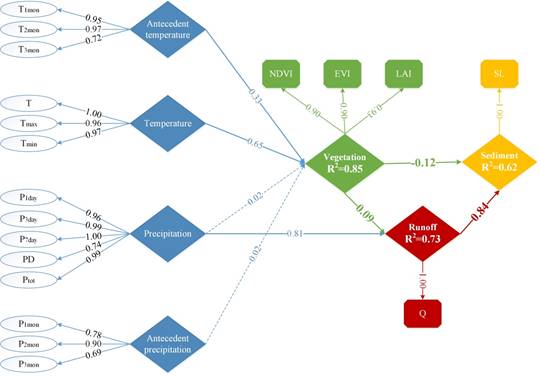Recently, Professor Yu Xingxiu's team from the Faculty of Resources and Environment Science of Hubei University made another breakthrough in the attribution analysis of sediment load change. The related achievement “The effect of climate and vegetation variation on monthly sediment load in a karst watershed” has been published in the international authoritative journal “Journal of Cleaner Production”. The first author was Cheng Si, a PhD candidate in Ecology from the Faculty of Resources and Environment Science in grade 2022, and Professor Yu Xingxiu was the second author.
The variation of monthly sediment load is nonlinear and non-stationary, and its response mechanism to climate and vegetation variation is complex. Therefore, it is challenging to quantify the direct and indirect effects of climate and vegetation variation on monthly sediment load, especially in karst areas where a complex geological structure region experiencing serious soil erosion and fragile ecological environment. The objective of this study was to decouple the impacts of climate and vegetation changes on the monthly sediment load in a karst watershed using partial least squares-structural equation modeling (PLS-SEM). Results indicated that climatic factors explained up to 85% of the variation in monthly vegetation. Climatic factors and vegetation dynamics together explained 73% of the variation in monthly runoff, while climatic factors, vegetation dynamics, and runoff accounted for 62% of the monthly sediment load changes (Fig.1).

Fig.1 Results of the PLS-SEM analysis.
Climate change can not only directly alter vegetation and hydrological characteristics, but also indirectly affect hydrological characteristics by changing vegetation dynamics, thus affecting the cooperative processes of runoff and sediment load. Specifically, runoff and precipitation had a positive impact on monthly sediment load, while antecedent temperature, temperature, antecedent precipitation, and vegetation dynamics had a negative impact (Fig.2).

Fig.2 Relationships among potential variables (direct, indirect, total impact)
PLS-SEM is a practical method to illustrate the complex coupling relationship framework, and can decouple the interrelated relationships between the sediment load and its influencing variables. This study is helpful to further understand the mechanism of sediment load change in the watershed and can provide scientific basis for rational utilization of soil and water resources and intelligent management of the watershed.
This research was carried out in collaboration with Li Zhenwei's team at the Institute of Subtropical Agriculture of the Chinese Academy of Sciences. This study was supported by the State Key Program of the National Natural Science Foundation of China and the National Key Research and Development Program of China. Professor Yu Xingxiu's team has been committed to the research of soil erosion and ecological restoration. Recently, with Hubei University as the first author unit, many high-level papers have been published in international authoritative journals such as Catena, Journal of Cleaner Production and Journal of Hydrology.
Link to paper:https://doi.org/10.1016/j.jclepro.2022.135290